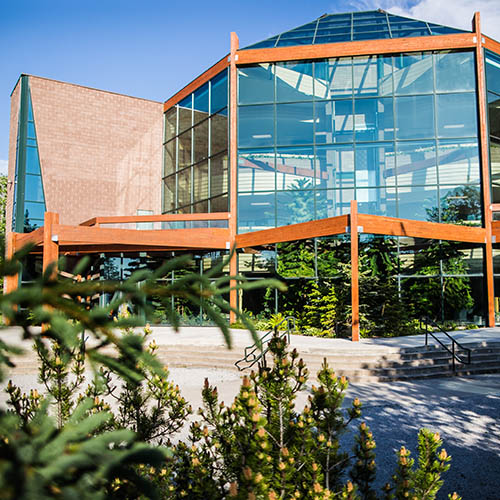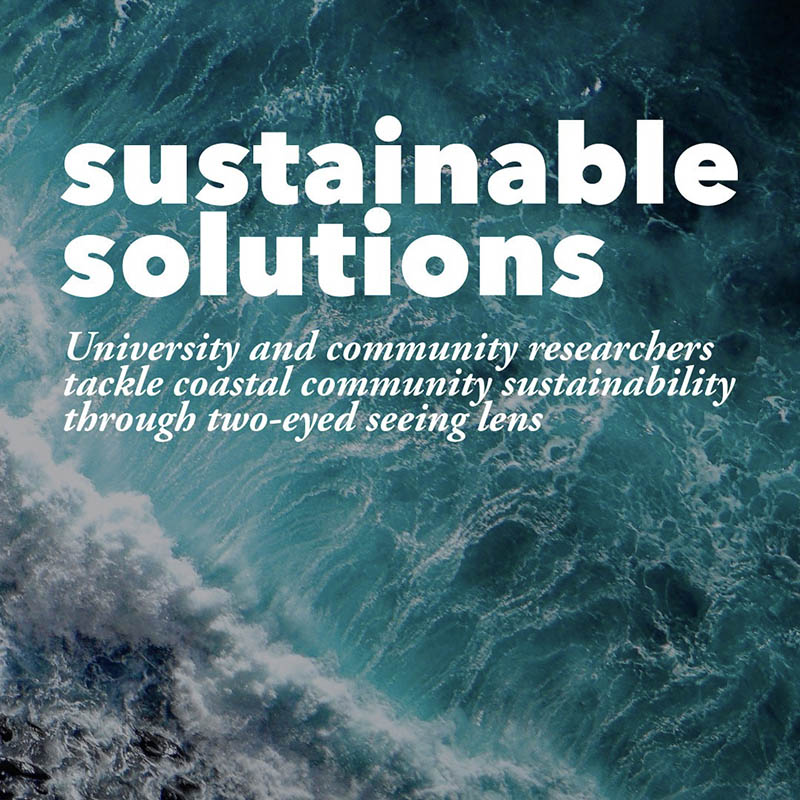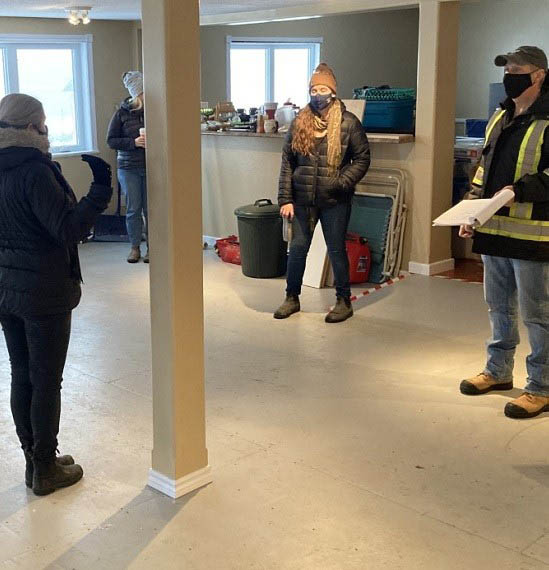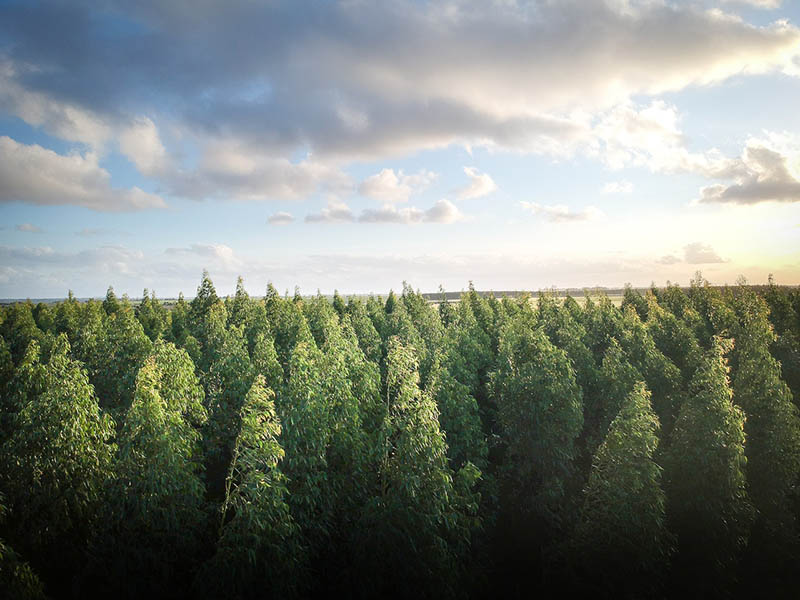Research Report: 2021
▼ Choose a report:

Powered by Research & Graduate Studies

Powered by Arts and Social Science

Powered by Fine Arts

Powered by Science and the Environment

Jump To:

University and community researchers tackle coastal community sustainability through Two-Eyed Seeing guiding principle
University and community researchers tackle coastal community sustainability through Two-Eyed Seeing guiding principle Memorial University and a consortium of university-affiliated and community-affiliated researchers from local Mi'kmaw communities across Newfoundland have been awarded nearly $15 million through the federal New Frontiers in Research Fund (NFRF) to investigate how repurposed marine biomass can develop new products and create a more sustainable future for Newfoundland and Labrador's coastal communities.
The large-scale, interdisciplinary project, supported through NFRF's Transformation stream, is titled "Repurposing marine by-products or raw materials for the development and production of functional foods and bioactives to improve human health and coastal community sustainability." Dr. Raymond Thomas, the nominated principal investigator, is a professor of environmental chemistry at Memorial's Grenfell Campus in Corner Brook, NL. The co-principal investigator, Dr. Kelly Anne Hawboldt, is a professor in the Department of Process Engineering, Faculty of Engineering and Applied Science, at the St. John's campus. There are many other researchers involved in this project from Memorial University and universities around the world.
Together, they've brought together a team of global collaborators, ranging from local Mi'kmaw communities and businesses from Newfoundland, colleagues from Dalhousie University, Mount St. Vincent University, University of Waterloo, and Cape Breton University as well as international partners from Ireland, Japan, Italy, and Australia. This team will investigate marine biomass and marine functional foods with a view to repurposing by-products and raw materials for the development and production of functional foods, bioactives, and biomaterials with the ultimate goal of improving human health and coastal community sustainability.
"This is an example of the exemplary research being conducted at Memorial University," said Dr. Vianne Timmons, vice-chancellor and president. "As is stated in Transforming Our Horizons, our new strategic plan, we have a special obligation to the people of our province. This major funding success is focused exactly on that - research that, while global in application, aims to better the lives of the people of Newfoundland and Labrador.""
The funding announcement is a historic one for Grenfell Campus.
"In the midst of a global pandemic, this project team has realized the largest Tri-Agency grant Grenfell Campus has ever received, one that will bring together Mi'kmaw groups and other experts from around the world to address sustainability," said Dr. Ian Sutherland, vice-president (Grenfell Campus) Memorial University. "We are immensely proud of this team, these partners, and are proud to play a leadership role in bringing them together to address core challenges facing the world today."
The project is looking for sustainable solutions to coastal ecological, economic, and social issues. Dr. Thomas views economic innovation as integral to sustainability.

"We're aiming to identify new products by repurposing marine waste with applications in agriculture, food, nutraceuticals, biomaterials, and health industries," he said, adding that a fundamental part of the research includes assessment of the socioeconomic implications and commercial value of any product and potential new revenue streams for firms. "We propose an integrated approach to assess, repurpose, and develop novel or innovative products and processes from marine raw materials for the benefit of coastal communities."
The project employs a collaborative multidisciplinary research approach that integrates Western knowledge systems and Indigenous knowledge systems. Two-Eyed Seeing, a Mi'kmaw conceptual framework for research developed by Elder Albert Marshall, embodies deep cross-cultural collaboration between non-Indigenous and Indigenous research teams by using both "eyes" to consider a problem - one eye representing Western knowledge and the other eye representing Indigenous knowledge systems. By working toward integrating Two-Eyed Seeing, this research recognizes that utilizing Indigenous knowledge systems alongside Western knowledge systems can result in rigorous, evidence-based, contextually appropriate economic revitalization in rural coastal regions.
The consortium includes Mi'kmaw leaders from across western Newfoundland: Chief Jasen Benwah (Benoit First Nation), Chief Mi'sel Joe (Miawpukek First Nation); Chief Mildred Lavers (Mekap'sk Mi'kmaq Band), Chief Joanne Miles (Flat Bay Band), Chief Rhonda Sheppard (St. George's Indian Band), and Chief Peggy White (Three Rivers Indian Band). The team is also collaborating with the Qalipu Development Corporation (QDC).
"I am so pleased to be part of this innovative project. As an Indigenous leader, I believe we must respect our land and water," said Chief Joanne Miles of the Flat Bay Band. "This project reflects some of our traditional way and our ancestors would be proud to see this concept come to life."
The project is also providing an excellent opportunity for post-doctoral fellows, graduate students, and undergraduate students who will gain new skills in the integration of coastal sustainability, entrepreneurialism, and ocean-based research. By integrating socioeconomic and lab-based product research working toward Two-Eyed Seeing, the research team plans to enhance the capacity of rural, coastal, and Mi'kmaw communities to participate in and benefit from innovative marine-based commercial opportunities.

In addition to the NFRF grant, the project has leveraged strong industrial and institutional support, including St. Anthony Basin Resources Inc. (SABRI), Clearwater, Qalipu Development Corporation, AbriTech Inc., Carino Processing Ltd., Newfoundland Aquaculture Industry, Association, Growing for Life, Newfoundland Aquaponics, NL Seaweed Company and NL Marine Organics.
The project comprises eight work-packages that focus on:
"We emphasize community engagement and the co-creation of knowledge between all partners, and aim to build new networks for product development," said Dr. Hawboldt. "Our approach recognizes that social and cultural sustainability and healthy populations are vital to resilient rural regions. While the research is taking place in Newfoundland and Labrador, the approach to developing new products and the framework for working with communities on sustainable development is global. The approach and framework will be exportable and applicable to ocean-based communities and industries worldwide."
The NFRF is under the strategic direction of the Canada Research Coordinating Committee. It is managed as a tri-agency program by the Social Sciences and Humanities Research Council (SSHRC), on behalf of Canada's three research granting agencies: the Canadian Institutes of Health Research (CIHR), the Natural Sciences and Engineering Research Council (NSERC) and SSHRC.

Sexton's sawmill. Bojan Furst image
Participants in a recent forestry knowledge-sharing event heard about everything from bio-economy and ecosystem mapping to silviculture and logging roads.
The free, online session, organized by the Canadian Forest Service and Grenfell Campus, Memorial University, brought together academics, government researchers, industry representatives and practitioners in the forest economy.
"Innovation and research are crucial to modernizing the forestry sector and responding to the pressing climate change and sustainable forest management challenges of today," said Karishma Boroowa, director, Atlantic Forestry Centre. "For these reasons, knowledge sharing events such as these are important for collective learning and identifying opportunities to advance the development of our sector."
A presentation by Bill Dawson, Newfoundland and Labrador Forest Industry Association, and Stephen Decker, a professor with the School of Science and the Environment, focussed on the opportunities and challenges they've met with respect to forest-based bio-economy development on the island.
"Forest-based Bio-economy Development in Newfoundland" is a research project led by NL Forest Industry Association and funded by the NL Workforce Innovation Centre (NLWIC).
In a forest-based context, bioeconomy involves the use of forest resources to create sustainable alternatives to fossil-fuel based products and services, while adding value to traditional forest-based products, supporting the identification of new products and markets, and consequently, support a more diverse and robust workforce.
The project uses case studies of key forestry dependent communities in Newfoundland. One such case study region is focused on the sawmill in Bloomfield, NL: Sexton Lumber.
Researchers have been working with the owners of the sawmill, stakeholders, and possible partners to identify assets and resources associated with the enterprise, as well as potential opportunities, technologies and training for under-represented members of the workforce.
Using waste streams to benefit agriculture and other sectors has emerged as a potential basis for new partnerships and projects, said Dr. Decker.
"A lot of the ideas we heard centred on what's referred to as 'waste heat' from sawmilling processes. A number of stakeholders said it would great if we could capture this heat or even steam, and use it to support other co-located processes," he said, adding that the heat discharged from the sawmill operations could be used to heat a nearby building or a greenhouse while other residues could be used in support of agricultural operations.
From a workforce perspective, some study participants suggested that skilled laborers already in place at local mills could share their expertise to support co-located ventures, such as food production facilities. Similarly, others have suggested that the forest industry's local skilled workforce could even provide mentorship opportunities to encourage entry into the workforce by currently under-represented groups such as women, youth, and Indigenous peoples.
Other presentations at the forestry event included:
"We're pleased to partner with CFS and to be a supporter of these kinds of opportunities - to provide places where researchers and practitioners can share ideas, learn from each other, and forge partnerships that will benefit the people of the province," said Ken Carter, director, Research and Engagement at Grenfell Campus.
To learn more, check out the recording of the event on the Grenfell Campus's Facebook page.
The NL Workforce Innovation Centre (NLWIC), administered by the College of the North Atlantic (CNA), has a provincial mandate to provide a coordinated, central point of access to engage all labour market stakeholders about challenges, opportunities and best practices in workforce development. The Centre's goal is to promote and support the research, testing and sharing of ideas and models of innovation in workforce development that will positively impact employability, employment, and entrepreneurship within the province's labour force and particularly under-represented groups. Funding is provided by the Department of Immigration, Skills and Labour (ISL) under the Canada-Newfoundland and Labrador Labour Market Development Agreement.

Grenfell Campus is excited to announce that the Bonne Bay Aquarium & Research Station (BBARS), located in Norris Point, NL, is officially part of our campus. BBARS, traditionally part of the Faculty of Science, Memorial University, has a mandate to provide a venue for teaching, research and public outreach.
The BBARS has garnered national acclaim for its public aquarium, which is open to the public from May until October, and encourages visitors to see the wonders of Bonne Bay, with insights from student interpreters. This modern marine station was opened in 2002 in Gros Morne National Park, and is staffed by two full-time employees and up to eight seasonal employees. The facility is home to a public aquarium and touch tank, and is important for marine research as the geographic location provides rare access to waters that have been isolated from the Gulf of St. Lawrence since the ice age.
The facility is one of Memorial's primary research hubs, specializing in marine science. BBARS is also host to summer semester marine biology courses, and recently, has been used by arts and fine arts students from Grenfell Campus and other groups.
"The relationship between the Bonne Bay Aquarium & Research Station and Grenfell Campus has been established for many years," said Dr. Jeff Keshen, vice-president (Grenfell Campus). "The further cementing of this partnership will help us meet our strategic goals. Our recruitment initiatives will be supported by increased access for students to these exceptional research and learning facilities. Academic and research activities and opportunities will intensify, as will occasions for public engagement- all of which have been identified as priorities for Grenfell Campus."
Under the guidance of director Duncan McIlroy, the marine station has developed important business partnerships with local tour operators, research and advocacy groups, and the federal and provincial governments. The BBARS is also a supporter of the local spring music festival 'Tales Trails and Tunes' and hosts visiting performing artists year- round in the theatre.
"As we move into the next phase of our development under the auspices of Grenfell Campus, supporting the marine biology semester remains as a core part of our raison d'etre which is formalized in a memorandum of understanding with Memorial's Faculty of Science," said Prof. McIlroy. "We are also looking to diversify our public activities, including Indigenization of our programming to reflect our presence in the ancestral homelands of the Mi'kmaq and Beothuk, and to extend our shoulder season offerings."

GNP Collective tours the future Community Place location
A newly formed collective spanning Corner Brook to the tip of the Great Northern Peninsula is aiming to make the area a healthier and more sustainable place to live.
The Great Northern Peninsula (GNP) Research Collective, which aims to promote collaborative community research and development initiatives, has a particular focus in the areas of health and community sustainability. The initial aim is to establish the "GNP Community Place."
Joan Cranston, Coordinator for the Bonne Bay Cottage Hospital Heritage Corporation in Norris Point, and a strong advocate of the project, said there are specific characteristics that make the GNP Community Place project distinctive.
"The project offers a social enterprise solution to an identified issue - that is, a lack of access to health and wellness supports in the region," she said, adding that it uses an inter-disciplinary Collective Impact Approach as well as a "3-P" Partnership Model - Public/ Private/People. "Finally, the project will be evidence-based and supported by the involvement of the Great Northern Peninsula Research Collective, supporting the creation of local knowledge through research."
Recently a team from Grenfell Campus travelled up the Northern Peninsula to participate in meetings and site visits - a hybrid of socially distanced in-person, as well as online - to discuss some exciting possibilities.
"Community members from Port au Choix, Port Saunders, St. Anthony and Bonne Bay area, as well as faculty, staff and students from Western Regional School of Nursing and Grenfell Campus, engaged in presentations and discussions pertaining to a variety of subject areas, ranging from the actual purpose of the collective and what "community place" means, to regional sustainability, social enterprise and food security," said Jennifer Buxton, regional engagement and experiential learning co-ordinator.
In Port au Choix the group toured GNP Community Place (see photo), which will become a community hub for health and wellness, and food security initiatives. In St. Anthony they visited the GNP Health & Wellness Centre, participated in an outdoor walking tour of the town.
Renee Pilgrim, a registered acupuncturist and Chinese medicine practitioner, is a seventh-generation resident of St. Anthony, and founder GNP Health & Wellness. She also advocates this community-led initiative.
"We have to start at the root when it comes to health - how we eat and how we move our bodies are the foundation," she said. "Growing our own food offers a two-for-one opportunity to do both. The knowledge of many generations continues to be relevant - their resourcefulness will continue to support the great potential on the GNP. Reminding people of their own abilities and strengths empowers us all to become a healthier population, relying less on external care."
Towards the end of the weekend expedition, community members, business owners, farmers and officials from of the Town of St. Anthony gathered with research collective representatives to talk about food security. One of the goals is to build upon the research conducted by Dr. Greg Wood and the late Dr. Jose Lam, who studied the history of the Grenfell Gardens, and create a community-led approach to food sovereignty, such as building more community gardens or a greenhouse, increased access to local produce, and education on growing and storing your own produce.
"The goal is to build upon the legacy of the Grenfell Gardens through a community-led approach," said Ms. Buxton. "Ultimately, if successful, it would see the establishment of a working group focused on increasing food sovereignty in the St. Anthony area, and opportunities for collaborative research projects on food security and agricultural production in the region.
The GNP Research Collective continues to move forward on community-engaged research initiatives to support innovation, resilience and sustainability on the Great Northern Peninsula. For more information on how you can get involved, contact Ms. Buxton at jbuxton@grenfell.mun.ca.

The Aging Research Centre - Newfoundland and Labrador (ARC-NL) has awarded research and development grants and fellowships totaling just over $100,000 to support research related to aging in Newfoundland and Labrador. ARC-NL made the announcement of the recipients as Memorial University recognizes Research Week, November 22-26.
For the 2021 awards, ARC-NL received 11 applicants for its research and development grants available to researchers at Memorial University of Newfoundland and Labrador and 13 applications for fellowship grants available to master's- and doctoral-level students at Memorial University.
"We were very pleased with the quantity and quality of the applications we received for our 2021 awards program," said Dr. Veronica Hutchings, ARC-NL director. "The applications covered a broad range of topics and issues that are related to issues that face our growing aging population. We look forward to seeing the results of the research that ARC-NL has funded and sharing that knowledge to the broader community, particularly our older population."
The work of ARC-NL supports the Government of Newfoundland and Labrador's efforts to better understand and plan for demographic change and healthy aging across the lifespan. Through budget 2021, the provincial government has allocated $100,000 to assist ARC-NL in its efforts to address needs, issues and opportunities of an aging society.
"As the province's demographics continue to shift, having sound research will be key to helping the Government of Newfoundland and Labrador create policies and programs that support healthy aging," said the Honourable John G. Abbott, Minister of Children, Seniors and Social Development. "I would like to congratulate the recipients of this year's research and development grants and fellowships that support research related to aging in the province. I am pleased to see such a variety of research topics across disciplines and I look forward to learning about the progress made."
ARC-NL has awarded research grants totaling $75,000 with the support of funding provided by the Department of Children, Seniors and Social Development. The grants were awarded to:
This year's awards will also see ARC-NL partner with AGE-WELL for the first time to increase the amount of a fellowship award. Mr. Salehi is the first recipient of the ARC-NL and AGE-WELL Fellowship that will see his total award valued at $24,000. As Canada's technology and aging network, AGE-WELL brings together researchers, older adults, caregivers, partner organizations and future leaders to accelerate the delivery of technology-based solutions that make a meaningful difference in the lives of Canadians.
Including the 2021 awards, ARC-NL has awarded 31 grants and fellowships totaling just over $342,000 to Memorial University researchers and students since it was established in 2018. Those awards include 16 research and development grants totaling approximately $200,000 and 15 fellowships totaling $142,000.
"On behalf of Grenfell Campus and Memorial University, I want to congratulate this year's awards recipients and commend them for their commitment to advancing aging-related research," said Dr. Ian Sutherland, vice-president, Grenfell Campus, pro tempore. "As chair of ARC-NL's management board, I am quite pleased to see the diversity and quality of the research that is taking place related to aging. With Newfoundland and Labrador having a rapidly aging population, I look forward to working with ARC-NL to advance research on this very important topic to the people and prosperity of our province."
The full list of the research that ARC-NL has funded can be found here.
ARC-NL featured some of the aging-related research at a recent Virtual Open House that can be viewed here.

Main focus of the research is related to establishment of a greenhouse by utilization the waste heat energy from Corner Brook Pulp & Paper Mill to produce high-value vegetables in the hydroponic system. A comprehensive proposal has been prepared and has submitted to the CFI John R. Evans Leaders Fund (CFI-JELF).
Exploring the potential of Hydrochar in improving carbon sequestration and mitigating greenhouse gases (GHGs) emission in podzolic soils in boreal climate. Research group of Dr. Cheema has already initiated a research trial at Pynn's Brook Research Station to improve carbon sequestration, GHG measurement and soil quality and health through Biochar application. Recent reports advocate that hydrochar is an economical alternate of biochar for soil amendment. In Newfoundland, total cattle are around 11,300 heads with a potential to produce dairy manure (DM) in the tune of 12,942 ft3/day. Disposable of DM is a challenge and traditional application of DM for crop production has numerous environmental concerns.
Application of DM-based-hydrochar can be an economical and an environment-sustainable move. Dairy farmers can get multifold benefit if DM is converted to hydrochar. Benefit may include but not limited to improve soil health, improve carbon sequestration and reduce GHGs. Allied benefit may emerge as a rewarding opportunity in the form of an industry to produce hydrochar for local consumption and likely to export as well. Therefore, a literature search is in progress to understand factors affecting process of feedstock to produce hydrochar and also to understand the design of reactor. In this respect, a small segment of a proposal was prepared and has been submitted for funding to the Canadian Institute of Food Science & Technology (CIFST). After good command on the subject of hydrochar, a detailed research proposal will be prepared for a useful research to benefit the newfoundland.

Dr. Ana Hansted (Post Doctoral Fellow) is exploring opportunities for product development from pulp and paper industry biomass waste streams under the supervision of professors Dr. William Newell (Business) and Dr. Kelly Hawboldt (Chemical Engineering). The focus of the work is to investigate the use of waste currently generated at Corner Brook Pulp and Paper. Specifically, it investigates how waste ash from the biomass boiler, fir bark, and paper sludge could be repurposed.
The ashes are currently being sent to the local landfill, representing a cost to the company and environmental cost in terms of energy use and GHG emitted. Tests and analyzes revealed the potential use of ash as a soil amendment, cementitious material, or asphalt filler. Based on the analysis of the physical and chemical properties of the ash, use as a soil amendment is the most appropriate application. This has led to a partnership between Corner Brook Pulp and paper and local farmers for a large-scale application pilot project.
The paper sludge and fir bark, generated in the paper production process, are currently used as fuel for the site. However, sludge and bark are high in water which decreases the overall heating value of the fuel. Briquettes, produced from the bark and/or sludge using compression and heat, can potentially improve the biomass characteristics for burning, resulting in high-quality solid biofuel. Both materials (paper sludge and bark) presented satisfactory properties for briquette production, and the technical viability was confirmed in different moisture content adjustments.
Research is underway to study and assess hydrological processes in the Corner Brook Stream Catchment of Western Newfoundland using stable water isotopes. Water samples from precipitation, groundwater, stream water, urban surface runoff and snowmelt are being collected for isotopic analysis. The project's objectives are (i) to identify spatial and temporal variation of isotopes in precipitation, groundwater, stream water, urban effluent, and snowmelt in the catchment area; (ii) identify the contribution of different water sources to the streamflow of the study's catchment area.
Research project #1: “Forest-based Bioeconomy Development in Newfoundland” study. Industry partner: NL Forest Industry Association, funded by NLWIC . With Lucas Garcia (PhD, Trans-disciplinary Sustainability) and Sean Goldstein (University of Winnipeg in Environmental & Social Change)
5 case study regions were examined: Bloomfield (Bonavista) - Sexton Lumber; Cottle's Island (Cottles Island Lumber Company Ltd.); Hampden (Burton's Cove Logging); CBPP Ltd; the Northern Peninsula of NL.
Researchers met with mill owners, identified assets, and invited stakeholders to create partnerships. Following evaluation of case studies, a pan-provincial workshop to discuss province and or sector-wide implications - e.g., the need for training for co-located greenhouses, increasing women in the workforce - was held. Producers are now able to speak to the province with a unified voice. Project researchers/collaborators/partners are working on final report sections, including:
Research Project #2: Ongoing Partnership (collaborative project) with Nunatsiavut looking at ptarmigan distribution and population status. With student researchers Charlotte Montgomery, Michelle Saunders and Veronica Flowers (MAEP)
An ongoing partnership/collaborative project with Nunatsiavut working on Phase 2 of a project looking at responsible and effective engagement with Indigenous peoples concerning wildlife management/research. MAEP graduate student Veronica Flowers will be going into the communities of Nunatsiavut to hear local opinions on responsible research engagement before, during, and after research. Phase 1 included a literature review (of publications from across 4 regions of Inuit Nunangat) by now-graduated MAEP graduate student Charlotte Montgomery of responsible engagement/research in the north with Indigenous people (Indigenous self-determination, respect for traditional ecological knowledge, etc.)
Research Project #3: Turr/Murre waterfowl management. With MAEP Students Claire Brenton and Haley Myers.
Research is underway making use of both quantitative and qualitative studies. The quantitative study has been sent out to hunters through a license mailing list. The qualitative study involves interviews with various stakeholders including Indigenous groups in Newfoundland and Labrador. The research is funded through part-time employment with Canadian Wildlife Service, part of Environment and Climate Change Canada.
Project #4: Gros Morne Tourism Regional Implementation Project Review (https://www.gmtrip.ca/). With Cassidy McCarthy (MAEP)
Different enclaves have different approaches to tourism development and the construction of a regional plan is intended to bring a common approach throughout Gros Morne. Research included a survey of residents in communities regarding tourism, environmental sustainability, and related matters. MAEP student Cassidy McCarthy is reviewing the data and revisiting town councils to learn of their opinions on the process.
The Potential of Biofuels in NL's Energy Economy: A Transdisciplinary Case Study of CBPPL.
Global warming and climate change represent the most challenging crisis of this century. Fossil fuels have a significant share of responsibility in the current situation and the damage being done to the planet as they are used in almost every sector of activity (i.e., transport, energy, industry, etc.).
In collaboration with CBPPL, research is under way investigating ways to turn to biomass as an alternative energy source and a solution to GHG emissions from fossil fuels. With proper processing, biomass (organic material and derivatives) holds great potential in energy production, and CBPPL has biomass in abundance as byproducts of their day-to-day activities. We are looking at what form of energy fuel can be produced from CBPPL byproducts and provide ecological, economic, and social benefits. Results from the research will help reshape the energy policy in NL and clear the path toward phasing out fossil fuels in the province.
Waste management in the paper industry is a challenge. This is mainly due the amounts of paper mill sludges (PMS) accumulating during paper and paperboard production processes. Landfilling and Incineration are commonly applied to theses sludges, but are becoming a financial burden, as both require intensive pre-treatment and are starting to be regulated more heavily, due to environmental concerns. Hydrothermal Carbonization (HTC), a thermo-chemical process, is suggested as an alternative waste management method, as it aims to produce solid bio fuels or functional carbon materials from the waste PMS. Feasibility of PMS HTC was explored in a series of lab-scale experiments using CBPPL waste PMS. The produced solids (hydrochars) were characterized and the process performance was assessed using a range if performance indicators.
The process was determined to be feasible to apply to CBPPL PMS to produce materials with increased energetic and functional characteristics. Additionally, Process optimization was explored. The “process optimum” was found to be dependant on the intended use of the produced material, as different applications pose different requirements towards material properties. Solid fuel applications seem to be the most preferable. The data collected during this project can be used to model suitable conditions to optimize any of the examined process parameters. Accompanying this project, a comprehensive literature review and analysis of possible applications, as well as industrial requirements was produced as part of a Master's Thesis. This Thesis also contains a series of flow charts outlining possible future project strategies concerning product use cases, product quality, process design and monitoring, cost-structures and market research. The Thesis also contains references to different companies manufacturing and planning HTC plants on an industrial scale, which may help identify know-how holders and possible synergy partners in the industry.
Project #1: Evaluating the Potential for using Earthworms to Produce Commercially Viable Animal Feed and Vermicompost Biofertilizer from Paper Mill Sludge. With Dasinaa Subramaniyam (BEAS Master's student)
The main aim of this research project is to utilize sludge, an organic product emerging out of paper mill waste streams, to manufacture animal feed and vermicompost biofertilizer. These value-added products have the potential to be commercialized in the poultry and aquaculture industries and gardening and horticulture industries. The project will explore these possibilities from the perspectives of agricultural science, and business and market analysis.
Finding viable options to develop new products from paper mill sludge is commercially and environmentally beneficial, particularly in the context of Newfoundland and Labrador. In Western Newfoundland (NL), Corner Brook Pulp and Paper Ltd. (CBPPL) produces more than 130 MT of wet paper sludge daily. Currently the sludge is burnt in the boiler by mixing it with bark and used oil. The high water content of the sludge makes the energy conversion process less efficient as considerable amount of heat generated is lost in evaporating excess moisture. Burning sludge contributes to climate change as well. In this proposed project, we seek to convert this organic material into animal feed and vermicompost using earthworms.
Our previous work on earthworms with a mix of sludge and bark material has shown that they have high affinity to use the sludge material. Because of the high-water content of the sludge material the earthworms can be populated easily with minimal processing to the sludge. At the end of lifecycle earthworms will be harvested and processed to produce animal feed. The animal feed will be tested for the presence of essential amino acids and fatty acids and potential contaminants in case they are present. The remaining material with earthworm cast will be tested to be used as a valuable organic fertilizer. Therefore, all the sludge can be fully utilized in an environmentally friendly manner without creating waste. The research study will optimize the parameters needed to successfully complete the process with minimum retention time. Additional key component of this research will be studying the business implications of developing new products from this waste stream. In collaboration with a social scientist, we will research and make recommendations on product adoption and business plan as a component of local circular economy. Potential findings from this project can inform the creation of additional revenue streams for the mill while avoiding the environmental repercussions that come from burning organic material. Additionally, the local poultry and aquaculture industries would immensely benefit from this project as, currently, most of their animal feed is costly and imported from the mainland. Locally produced animal feed will help the province reach self-sufficiency in these animal products which would contribute toward NL's food security and the local economy, while also having a positive impact on CBPPL's environmental and business plans.
Project #2: Evaluating the potential of using a combination of bioremediation and phytoremediation for a hydrocarbon and heavy metal contaminated site. With Priyanthini Sathyaseelan & Natalie Parsons (BEAS Master's students)
The main aim of this research project is to develop and test a sustainable green remediation technology to bring down the contaminant levels in a hydrocarbon and heavy metal contaminated site so that it can be used for public use. Anthropogenic industrial activities can lead to accumulation of harmful hydrocarbons and heavy metals in soil environment which can have human health impact and may enter food chain affecting ecosystem as well. If these contaminations happen at a public site, then the space cannot be used by public unless the contaminant levels are brought down below the maximum allowable concentrations.
While several capital-intensive physical and chemical remediation technologies such as excavating and replacing the contaminated soil or excavating and soil washing or soil burning are available, these technologies can have lasting harmful impact on the soil environment and soil health. They can also be a financial burden to a public property for remediation. In situ biostimulation by adding nutrients, air, or microbes using natural soil amendments such as compost, and phytoremediation of hydrocarbon using rhizosphere breakdown by growing plants that have good root density, and up-taking heavy metals by growing suitable native phyto-accumulators can remediate the contaminated soil in the long run while being inexpensive and can also be good for soil health and to the environment at large. Promoting earthworm population onsite can also support in increasing the remediation of hydrocarbons. A demonstration of this combined environment-friendly phytotechnology can have ripple effect in remediating other public and private properties where the owners look for less capital-intensive and less harmful green technologies.

NSERC Alliance Proposal - submitted/led by Dr. Christina Smeaton
Garrett and Lakshman are part of the project. (Waiting for outcome).
This NSERC project is about exploring the effects of seaweeds on methane emission from soils. Dr. Lakshman Galagedara will be looking at the agricultural aspect of it.
Dr. Mumtaz Cheema is interested in a project for Living Lab of AAFC - Beneficial management to mitigate GHG emission and carbon sequestration (future project).
Natural Resources Canada's Energy Innovation Program
We are interested in the 3rd part of the project which focuses on utilization (expand the strategic uses of CO2), and support the development of cost and energy efficient utilization pathways (Winter 2023)
Interested members: Bill Dawson from NL Forest Industry Association and Dr. Kelly Ann Hawboldt, Engineering, St. John's Campus.